Контактные линзы. презентация.Щербак.ppt
- Количество слайдов: 12
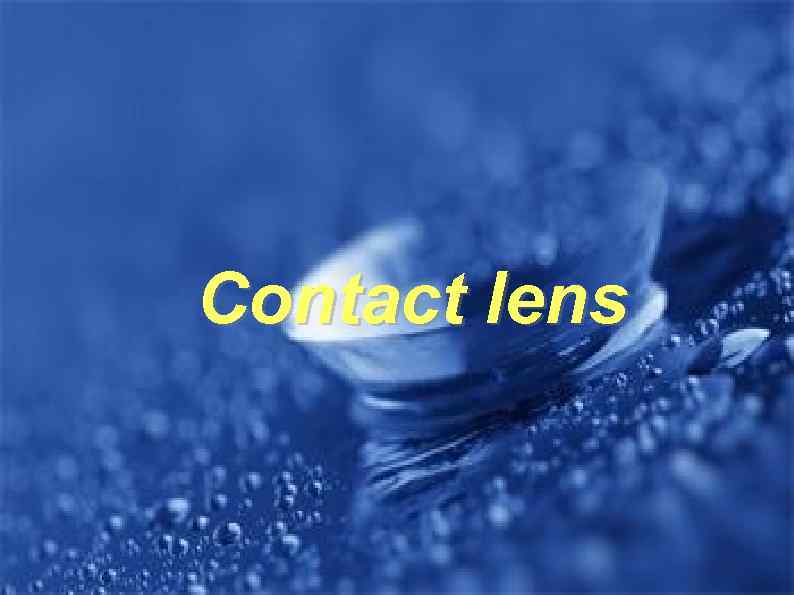 Contact lens
Contact lens
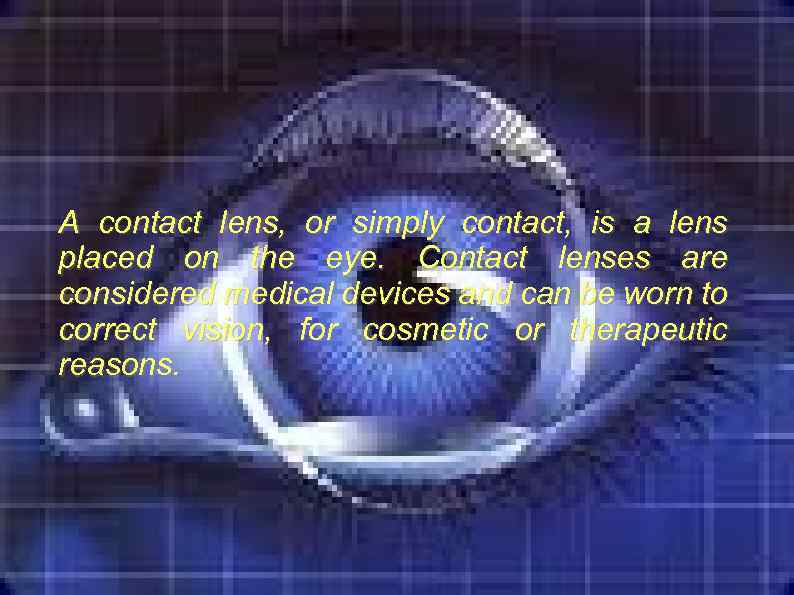 A contact lens, or simply contact, is a lens placed on the eye. Contact lenses are considered medical devices and can be worn to correct vision, for cosmetic or therapeutic reasons.
A contact lens, or simply contact, is a lens placed on the eye. Contact lenses are considered medical devices and can be worn to correct vision, for cosmetic or therapeutic reasons.
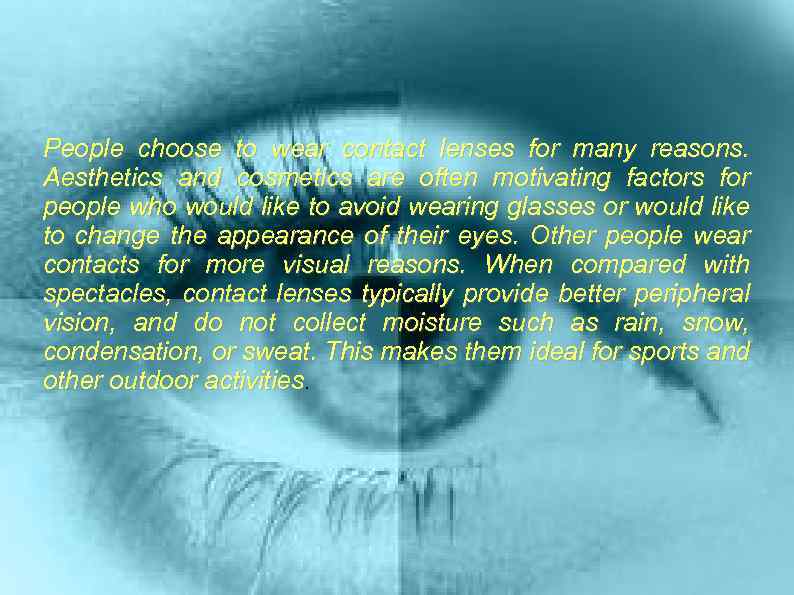 People choose to wear contact lenses for many reasons. Aesthetics and cosmetics are often motivating factors for people who would like to avoid wearing glasses or would like to change the appearance of their eyes. Other people wear contacts for more visual reasons. When compared with spectacles, contact lenses typically provide better peripheral vision, and do not collect moisture such as rain, snow, condensation, or sweat. This makes them ideal for sports and other outdoor activities.
People choose to wear contact lenses for many reasons. Aesthetics and cosmetics are often motivating factors for people who would like to avoid wearing glasses or would like to change the appearance of their eyes. Other people wear contacts for more visual reasons. When compared with spectacles, contact lenses typically provide better peripheral vision, and do not collect moisture such as rain, snow, condensation, or sweat. This makes them ideal for sports and other outdoor activities.
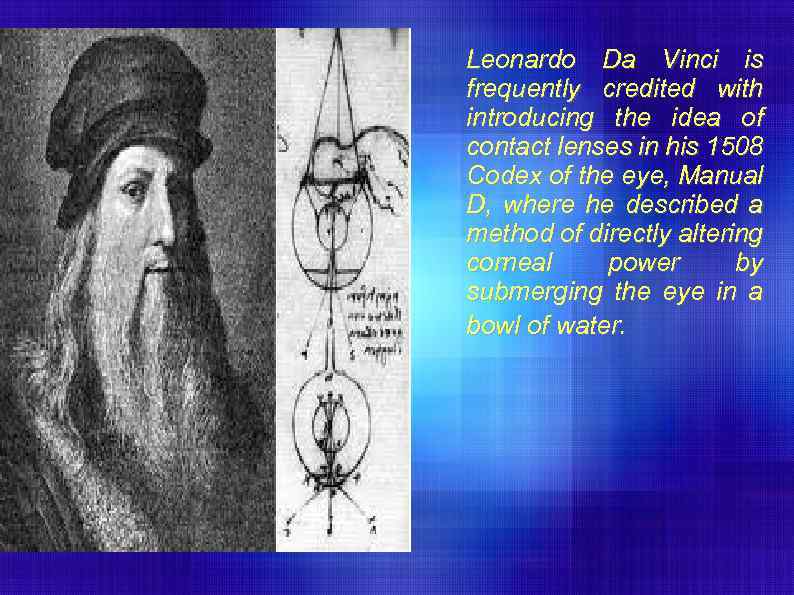 Leonardo Da Vinci is frequently credited with introducing the idea of contact lenses in his 1508 Codex of the eye, Manual D, where he described a method of directly altering corneal power by submerging the eye in a bowl of water.
Leonardo Da Vinci is frequently credited with introducing the idea of contact lenses in his 1508 Codex of the eye, Manual D, where he described a method of directly altering corneal power by submerging the eye in a bowl of water.
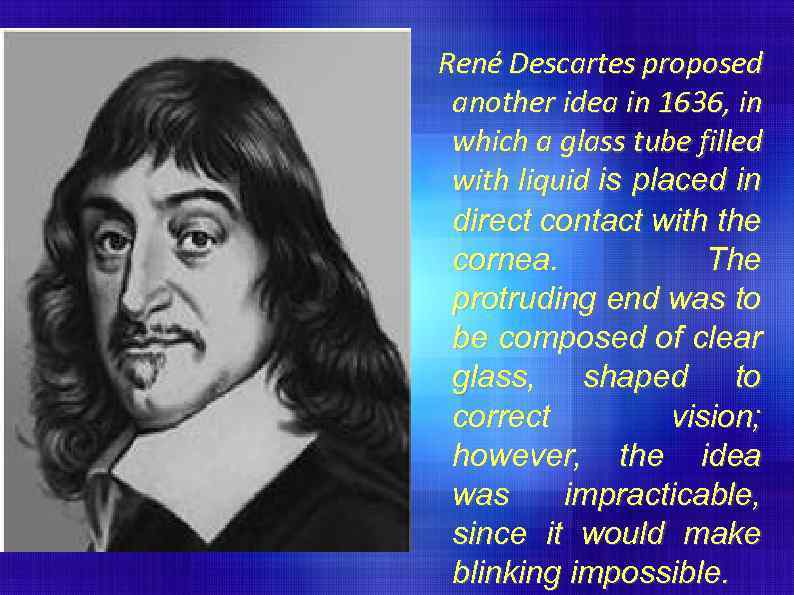 René Descartes proposed another idea in 1636, in which a glass tube filled with liquid is placed in direct contact with the cornea. The protruding end was to be composed of clear glass, shaped to correct vision; however, the idea was impracticable, since it would make blinking impossible.
René Descartes proposed another idea in 1636, in which a glass tube filled with liquid is placed in direct contact with the cornea. The protruding end was to be composed of clear glass, shaped to correct vision; however, the idea was impracticable, since it would make blinking impossible.
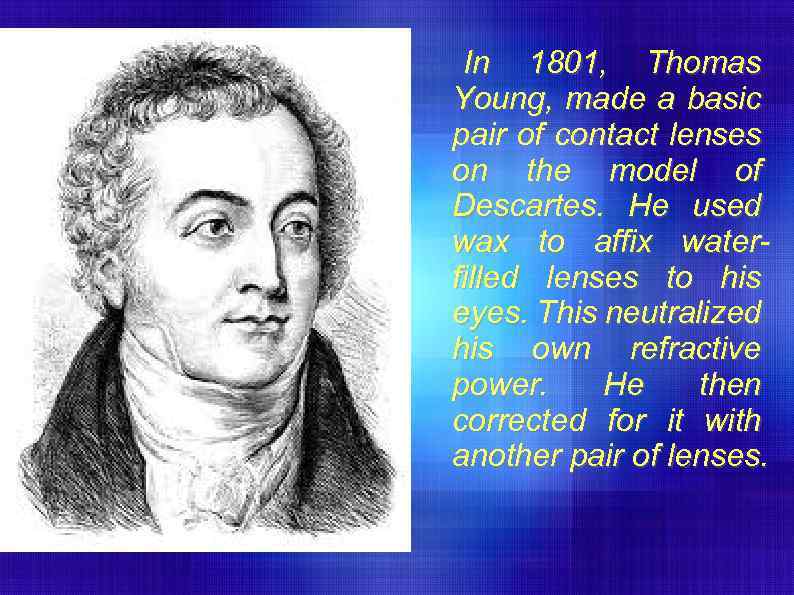 In 1801, Thomas Young, made a basic pair of contact lenses on the model of Descartes. He used wax to affix waterfilled lenses to his eyes. This neutralized his own refractive power. He then corrected for it with another pair of lenses.
In 1801, Thomas Young, made a basic pair of contact lenses on the model of Descartes. He used wax to affix waterfilled lenses to his eyes. This neutralized his own refractive power. He then corrected for it with another pair of lenses.
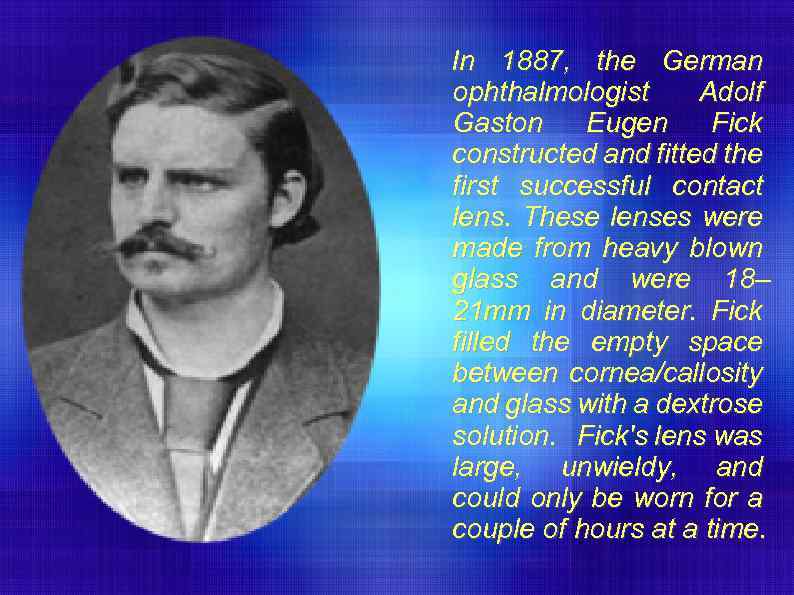 In 1887, the German ophthalmologist Adolf Gaston Eugen Fick constructed and fitted the first successful contact lens. These lenses were made from heavy blown glass and were 18– 21 mm in diameter. Fick filled the empty space between cornea/callosity and glass with a dextrose solution. Fick's lens was large, unwieldy, and could only be worn for a couple of hours at a time.
In 1887, the German ophthalmologist Adolf Gaston Eugen Fick constructed and fitted the first successful contact lens. These lenses were made from heavy blown glass and were 18– 21 mm in diameter. Fick filled the empty space between cornea/callosity and glass with a dextrose solution. Fick's lens was large, unwieldy, and could only be worn for a couple of hours at a time.
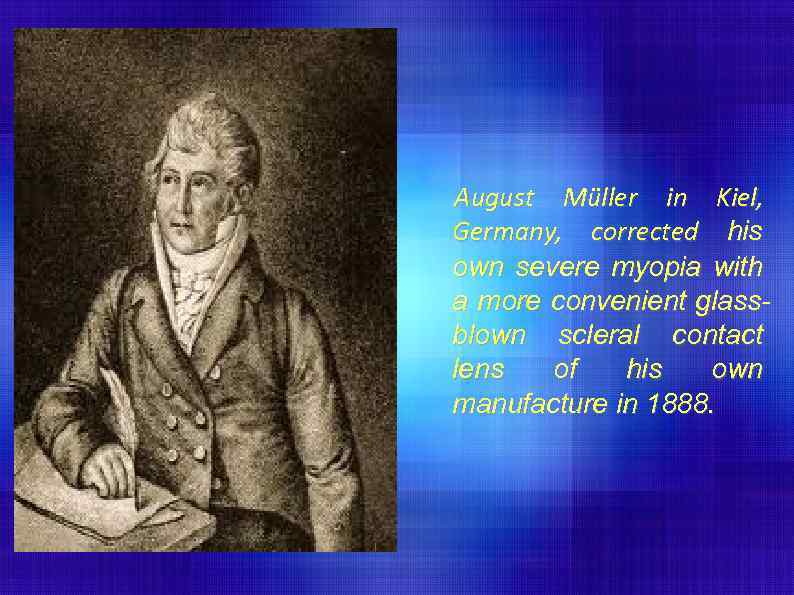 August Müller in Kiel, Germany, corrected his own severe myopia with a more convenient glassblown scleral contact lens of his own manufacture in 1888.
August Müller in Kiel, Germany, corrected his own severe myopia with a more convenient glassblown scleral contact lens of his own manufacture in 1888.
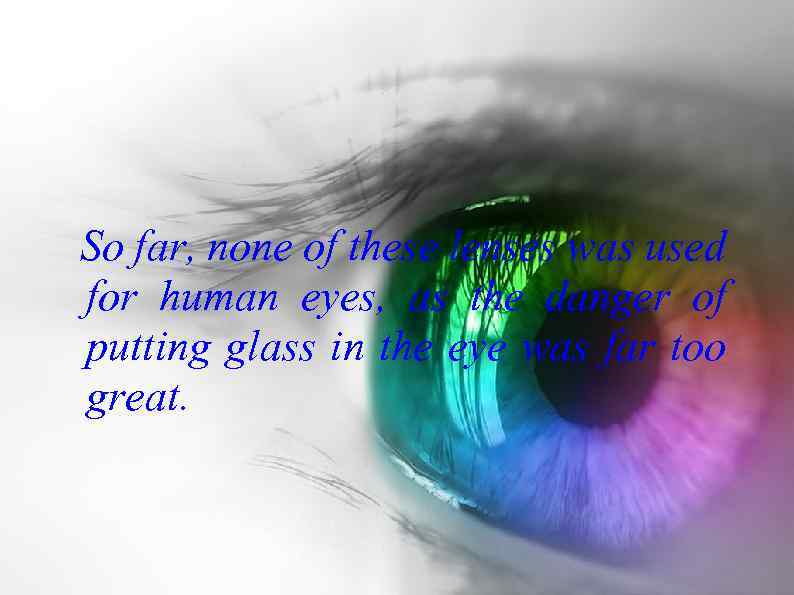 So far, none of these lenses was used for human eyes, as the danger of putting glass in the eye was far too great.
So far, none of these lenses was used for human eyes, as the danger of putting glass in the eye was far too great.
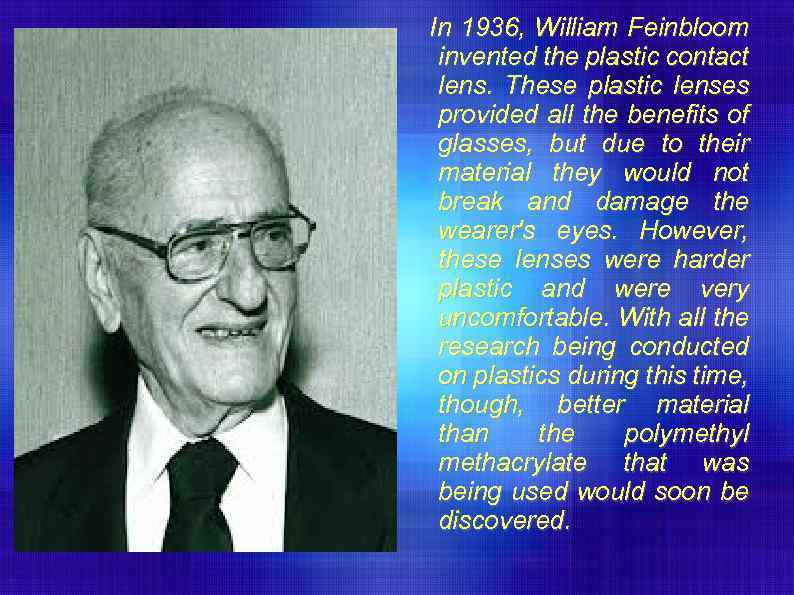 In 1936, William Feinbloom invented the plastic contact lens. These plastic lenses provided all the benefits of glasses, but due to their material they would not break and damage the wearer's eyes. However, these lenses were harder plastic and were very uncomfortable. With all the research being conducted on plastics during this time, though, better material than the polymethyl methacrylate that was being used would soon be discovered.
In 1936, William Feinbloom invented the plastic contact lens. These plastic lenses provided all the benefits of glasses, but due to their material they would not break and damage the wearer's eyes. However, these lenses were harder plastic and were very uncomfortable. With all the research being conducted on plastics during this time, though, better material than the polymethyl methacrylate that was being used would soon be discovered.
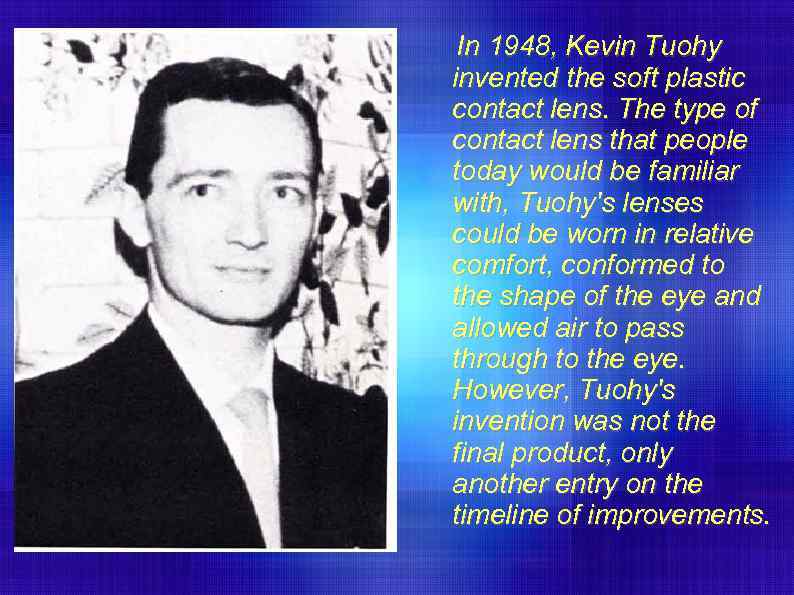 In 1948, Kevin Tuohy invented the soft plastic contact lens. The type of contact lens that people today would be familiar with, Tuohy's lenses could be worn in relative comfort, conformed to the shape of the eye and allowed air to pass through to the eye. However, Tuohy's invention was not the final product, only another entry on the timeline of improvements.
In 1948, Kevin Tuohy invented the soft plastic contact lens. The type of contact lens that people today would be familiar with, Tuohy's lenses could be worn in relative comfort, conformed to the shape of the eye and allowed air to pass through to the eye. However, Tuohy's invention was not the final product, only another entry on the timeline of improvements.
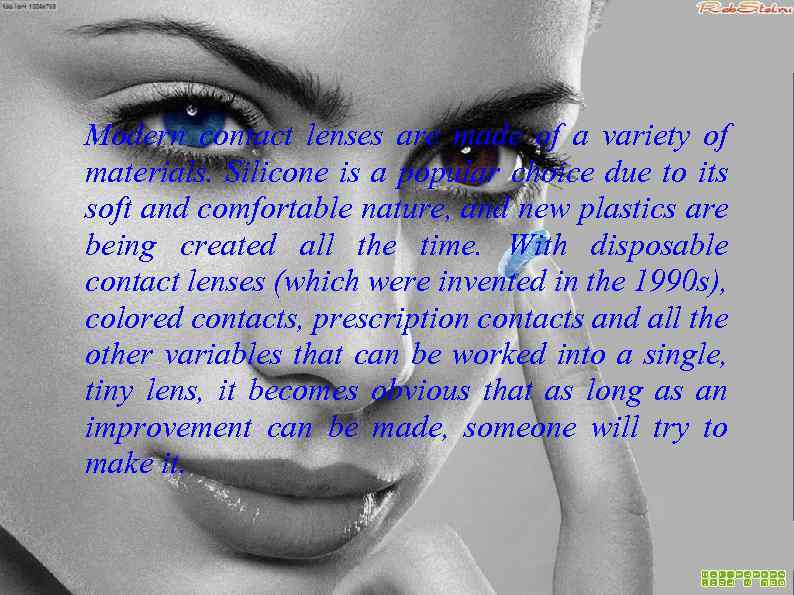 Modern contact lenses are made of a variety of materials. Silicone is a popular choice due to its soft and comfortable nature, and new plastics are being created all the time. With disposable contact lenses (which were invented in the 1990 s), colored contacts, prescription contacts and all the other variables that can be worked into a single, tiny lens, it becomes obvious that as long as an improvement can be made, someone will try to make it.
Modern contact lenses are made of a variety of materials. Silicone is a popular choice due to its soft and comfortable nature, and new plastics are being created all the time. With disposable contact lenses (which were invented in the 1990 s), colored contacts, prescription contacts and all the other variables that can be worked into a single, tiny lens, it becomes obvious that as long as an improvement can be made, someone will try to make it.
